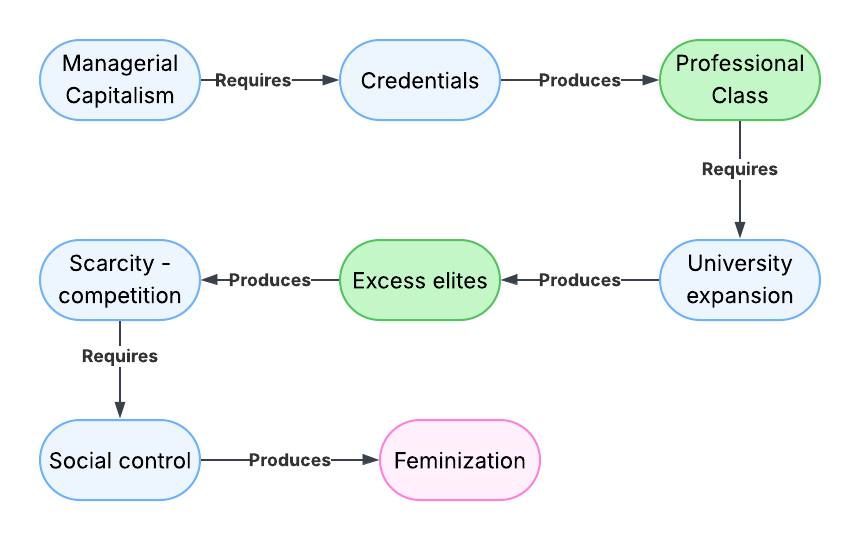This is my final post on feminization. I began writing about it two years ago to understand my own experiences in female society. Along the way, I discovered that feminization isn’t about women at all, but a system of incentives that shapes behavior in institutions. Now that the framework is complete, the subject feels closed. I’m ready to return to the many other topics I love. I’m no longer writing from old wounds, and 2025 was the best year of my life. That is because of you — thank you for changing my life.
I. Managerial capitalism as feminization
Managerial capitalism is the system that replaced family-owned enterprises. The owners of capital no longer control the operation. Salaried managers decide on the most efficient allocation of resources to produce goods for which demand must be created. Industrial and technological scaling created mass affluence, which in turn required managerial coordination beyond the capacity of owner-operators. Once affluence rose, production outpaced natural demand, making demand creation essential to absorb output.
Managerial capitalism fused with desire creation because mass production required continually generating consumer wants — the law of supply and demand appears natural, but doesn’t consider whether the demand is based on needs or desires. Desire creation and affluence are conditions of feminization under which discipline erodes. That is feminization in action — women did not bring it about. The earliest advertisers and managers of the new order were men.
II. Affluence and emotional governance
Affluence created expectations and heightened awareness of relative status, which forced production into perpetual overdrive. This created a new imperative: institutions now had to manage emotions and maximize comfort—both physical and psychological—to preserve the conditions for consumption. We amuse ourselves to death because discipline—the precondition for a meaningful life—has been eroded.
This manifested in my life through depression and my inability to emerge. I didn’t understand that fulfilling my desires at all times was a source of my misery. Discipline isn’t about denial or suppressing emotions but the ability to discern the best path for oneself amid temptations.
III. Credentialism & status competition
The rise of large-scale corporations created a demand for credentialed administrative and technical roles. It began with medicine and engineering, then expanded until credentialed professionals governed even those in physical trades. In early corporations that produced physical products, engineers and financial managers rose to the top of the professional class. When knowledge work became the primary corporate output, universities mass-produced aspiring elites that society could not absorb.
IV. Feminization defined
Feminization is a system of behavioral norms that institutions adopt, not the behavior of women. Feminine behavior is personal while feminization is institutional.
Men can also adopt and encourage such norms, and women might also resist them. You probably know other women who are feminine but nevertheless resist feminization. Feminization is a behavioral operating system that has fused with managerial capitalism to create an affluent society allergic to truth.
V. Elite overproduction & feminized competition
Elite overproduction intensifies feminization. As competition for status intensified, the elite's competitive mode morphed. Competition shifted from overt to covert; hierarchy was moralized even as it remained unavoidable; and perception management became paramount. The adage “perception is reality” is the essence of the feminized operating system.
The masculine and feminine modes of competition undertaken in groups are mirrored in institutions, but therein become disconnected from the original groups.
The dominant competitive mode in modern institutions is feminine-coded, which gives women a natural advantage within it. This is feminized competition, but it isn’t limited to women. Conversely, women resisting this mode exist, though they’re in the minority. This feminized mode suppresses original thinkers of both sexes, making genuine meritocracy impossible. The question is whether workplaces were tilted toward feminized competition before or after the gender tipping point. In fact, feminization of institutions predated women’s mass entry to the workforce and is more closely tied to rising affluence, intensified competition for professional jobs, and rapid technological advancement.
VI. The conditions required for truth
Truth can only flourish under open, hierarchical, merit-based competition. Historically, men were incentivized toward competition and women toward cooperation, so these competitive modes map onto their group behavior. But it is crucial to note that these are not biologically determined, but the results of incentives over millennia. Incentives govern human behavior, yet many refuse to acknowledge this because it feels immoral to admit we act in our own interest within a competitive society.
It should be a precondition of public influence to be able to compete openly and argue logically. Social coercion has become the default instead. Unfortunately, the prevalence of social control within the feminist context has made this sort of control female-coded. Social control cannot be the basis of power in a functioning society, though it does become the case in an affluent one. Competition is also denied and discouraged, even as you are forced into it — another hallmark of a society unable to allocate status meritoriously.
One reader objected to a recent line of argument in which I illustrated masculine and feminine archetypal traits using the Indic examples of purusha and prakriti. He argued there’s no empirical proof that they exist, yet you can see them everywhere in nature. These concepts cannot be validated through that narrow empirical lens, despite the professional class treating empiricism as the sole standard of legitimacy. I’m not against experimentation and hypothetical testing, but these concepts can’t be proven through that mundane lens.
The male and female competitive modes reflect the archetypal masculine and feminine qualities found in all people. Most women I know tend toward feminine traits, but I know several women who’d be described as ‘masculine’ in inner orientation. I view autonomous and independent people, regardless of sex, as ontologically masculine because their orientation is outward, they openly compete, and aren’t afraid of risking their status. The feminine orientation prioritizes consensus and belonging, but when taken to extremes, it sacrifices agency. Women’s society isn’t for me, because most women prefer this mode of being in the world. I’m grateful for the women in my life with a masculine orientation, and I can appreciate what it cost them socially among women.
Ultimately, feminized institutions break the dialectical process required to reach truth. The correct solution to a problem can only emerge when ideas are sharpened, but the feminized competitive mode prevents this through social punishment of independent thought. This is precisely what I can’t swallow, so I write. Standards become impossible to uphold, and ‘personal truth,’ or perception, becomes reality.
I take writing for you more seriously than my career. I began because I needed to say the things that are plain, but few are willing to say. I also write under my real name because you all made me unafraid of the risk. If I have put words to what you feel (or gave you ammunition for your arguments), please consider becoming a paid subscriber.














